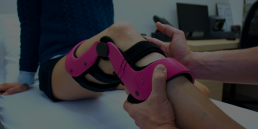In sports, where performance is at the forefront of concerns, athletes seek ways to optimize their training and minimize injury risks. Orthotics can play a crucial role! Far from being limited to post-operative use or injury recovery, orthotics are increasingly recognized for improving stability, supporting the lower limbs, and preventing injuries. In this article, EVO explores the importance of orthotics in sports and their benefits for athletes.
The Benefits of Orthotics for Athletes
Support and Stabilization
Orthotics stabilize the body parts most strained during physical activity by providing additional support to joints and muscles. For example, ankles are exposed to sudden movements in soccer or basketball, which can lead to injuries. An ankle orthotic provides essential support to prevent sprains and other joint injuries, giving athletes a sense of security. Likewise, for tennis players who put intense strain on their wrists, wrist orthotics help stabilize repetitive movements and reduce pressure on the joints.
Injury Prevention
Using appropriate orthotics can effectively prevent the most common injuries among athletes (plantar fasciitis, ankle osteoarthritis, anterior cruciate ligament injuries). A 2018 study showed that wearing a prophylactic knee orthotic could prevent/reduce the risk of MCL and ACL injury recurrence in ice hockey players in Switzerland.
Recovery and Rehabilitation
Whether after knee surgery or managing a chronic injury, orthotics can facilitate faster and safer recovery. For example, after anterior cruciate ligament surgery, an orthotic provides the necessary support to stabilize the joint and allow gradual rehabilitation.
Performance Optimization
Beyond injury prevention and recovery, orthotics can also optimize athletic performance. By providing better stability and reducing muscle fatigue, they allow athletes to focus on their technique without fear of injury. A 2018 study on running showed that wearing orthotics increased comfort and running speed while reducing the risk of injury. Athletes like LeBron James or Tiger Woods, who use orthotics to enhance their performance, are a testament to the control and confidence these tools can provide!
Types of Orthotics Used in Sports
Plantar Orthotics
Plantar orthotics benefit sports involving intense running, such as soccer, running, or rugby. They correct biomechanical imbalances and improve posture to reduce the risk of injuries (plantar fasciitis, shin splints, etc.).
Knee Orthotics
Knee orthotics are commonly used in contact or pivot sports, such as American football, skiing, or basketball. They provide lateral support and protect ligaments to reduce the risk of severe injuries, such as anterior cruciate ligament tears.
Wrist Orthotics
Wrist orthotics are often used by tennis players, gymnasts, and other athletes who heavily rely on their wrists. They stabilize the joint and prevent injuries like tendinitis or carpal tunnel syndrome.
Ankle Orthotics
Ankle orthotics are crucial for sports requiring jumps or quick changes in direction, such as basketball, volleyball, or soccer. They stabilize the ankle joint and limit sudden movements, helping to prevent sprains and other common injuries in these sports.
Our Tips for Choosing the Right Orthotics
According to the Type of Sport
- Running sports (running, soccer, etc.): Plantar orthotics absorb shocks, correct posture, and prevent foot and lower limb injuries.
- Pivot/contact sports (basketball, American football, etc.): A knee orthotic provides lateral support and protects ligaments from twists and impacts.
- Sports that heavily use the wrists (tennis, gymnastics, etc.): A wrist orthotic stabilizes the joint and prevents tendinitis.
The choice of orthotics should be adapted to the type of movements and stress the sport imposes on the body.
According to Injury History
If an athlete has previously suffered injuries, orthotics can help prevent their recurrence, bringing a sense of comfort and well-being.
- History of plantar fasciitis: A well-fitted plantar orthotic can help distribute pressure on the foot, relieve pain, and prevent recurrences.
- Knee injuries: A sturdy knee orthotic that limits lateral movements while allowing some flexibility is recommended for athletes who have undergone anterior cruciate ligament surgery.
- Repeated ankle sprains: An ankle orthotic that stabilizes the joint and prevents twisting movements can help prevent future sprains.
According to Biomechanical Particularities
Each athlete is unique, and individual biomechanical characteristics must be considered when choosing orthotics. This includes:
- Foot structure: Some athletes have flat feet, while others have high arches. These differences can influence the type of orthotic needed to correct posture and prevent injuries.
- Lower limb alignment: Imbalances or deviations in the alignment of the legs, knees, or ankles may require custom orthotics to compensate for these anomalies.
- Weight distribution: Improper weight distribution on the feet can cause excessive strain on specific body parts, requiring orthotics to correct this imbalance.
Consultation with Health Professionals
If you need orthotics for your sports needs, consult health professionals, such as podiatrists, physiotherapists, or orthotists like EVO. Together, we assess your needs through a complete diagnosis, recommend personalized solutions, and ensure follow-up to keep your orthotics well-fitted.
Beware of Off-the-Shelf Orthotics
Yes, off-the-shelf orthotics are readily available and often cheaper. However, they are not always suited to every athlete’s needs. Poorly fitted or low-quality orthotics can be ineffective, worsen an existing condition, or cause new injuries.
Conclusion
Orthotics are much more than simple support devices. They are crucial in injury prevention, post-injury recovery, and athlete performance optimization. Whether you’re an amateur or professional athlete, orthotics are your allies in sports and health. Book your appointment with EVO Laboratory and optimize your athletic performance today!
Share this article
Related posts
April 1 2022
Ski Orthosis : 3 Good Reasons to Wear It
December 6 2019


